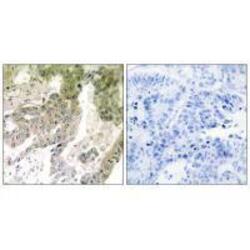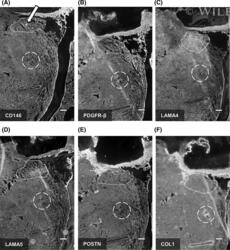Antibody data
- Antibody Data
- Antigen structure
- References [1]
- Comments [0]
- Validations
- Immunohistochemistry [1]
- Other assay [1]
Submit
Validation data
Reference
Comment
Report error
- Product number
- PA5-49930 - Provider product page

- Provider
- Invitrogen Antibodies
- Product name
- Laminin alpha-5 Polyclonal Antibody
- Antibody type
- Polyclonal
- Antigen
- Synthetic peptide
- Description
- The antibody detects endogenous levels of total Laminin alpha-5 protein.
- Reactivity
- Human, Mouse
- Host
- Rabbit
- Isotype
- IgG
- Vial size
- 100 μL
- Concentration
- 1 mg/mL
- Storage
- -20°C
Submitted references Spatiotemporal extracellular matrix modeling for in situ cell niche studies.
Olesen K, Rodin S, Mak WC, Felldin U, Österholm C, Tilevik A, Grinnemo KH
Stem cells (Dayton, Ohio) 2021 Dec;39(12):1751-1765
Stem cells (Dayton, Ohio) 2021 Dec;39(12):1751-1765
No comments: Submit comment
Supportive validation
- Submitted by
- Invitrogen Antibodies (provider)
- Main image

- Experimental details
- Immunohistochemical analysis of Laminin alpha-5 in paraffin-embedded Human lung carcinoma tissue using Laminin alpha-5 Polyclonal Antibody (Product # PA5-49930).
Supportive validation
- Submitted by
- Invitrogen Antibodies (provider)
- Main image

- Experimental details
- 6 FIGURE Region of interest identified by the StEMM is also present in the native heart and partly defined by laminins. The region of interest which was identified in the StEMM was confirmed by immunohistochemistry of native rat hearts: (A) CD146 expression was clustered in the middle of the AVJ region (dotted region), as well as in the PVN (dashed circle). B, PDGFR-beta was also expressed in the PVN, in the aortic valves and aortic root, but not in the AVJ. C, LAMA4 was more generally expressed in the heart, with predominance in the AVJ. D, LAMA5 was also found in all parts of the heart, but with no predominant regions. E, POSTN was identified in the aortic valves and root with thin streaks into the AVJ. F, The aortic valves and root together with the PVN also stained positive for COL1, but not the AVJ. In the figure: scale bars = 200 mum. AVJ, atrioventricular junction; COL1, collagen 1; LAMA4, laminin alpha4; LAMA5, laminin alpha5; PDGFR, platelet derived growth factor receptor; POSTN, periostin; PVN, perivascular niche; StEMM, spatiotemporal extracellular matrix model
 Explore
Explore Validate
Validate Learn
Learn Western blot
Western blot Immunohistochemistry
Immunohistochemistry